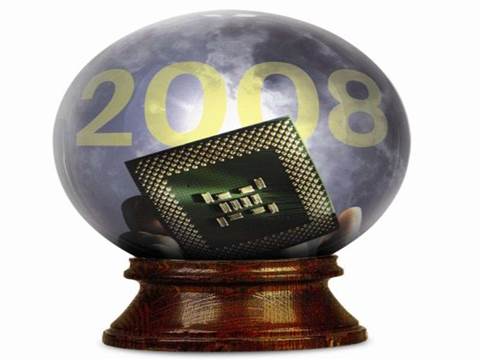This year looks to be filled with technological innovation and oversold hype in the processor arena, with business rumours that don’t pan out and surprises that shock us all. Here, a panel of industry experts comprising vendors, analysts and solution providers discuss what they think will be the most important chip stories in 2008.
1 Is AMD on the brink?
Advanced Micro Devices Inc. had a rough 2007, losing hundreds of millions of dollars each of the three quarters it has reported earnings for this year.
AMD CEO Hector Ruiz doesn’t expect profitability until the third quarter of 2008. So, the question becomes, can AMD survive any more setbacks? Some on the panel fear that if all doesn’t go well, the company could be broken up in 2008 or 2009.
“If AMD is not able to compete in the server space, it would be devastating to [its] recovery,” said IDC analyst Shane Rau. “If AMD misses a Q4-Q1 cycle, we’re going to be looking at Q4 08-Q1 09 for the next big opportunity.”
Joe Toste, vice president of marketing at Equus Computer Systems, said the irony is that the industry needs a strong AMD. “But this is the year that Intel shifts its paranoia from AMD to Nvidia. [Intel CEO Paul] Otellini was really upset that Apple notebooks went to Nvidia.”
2 Intel’s game of monopoly
The world’s biggest semiconductor company continues facing lawsuits and anti-trust proceedings in a number of venues worldwide. Intel denies all charges and allegations.
F. Scott Kieff, a law professor at Washington University in St. Louis, who specialises in anti-trust regulation in the technology sector, said Intel is “getting unfairly beaten up” on anti-trust matters and could face stiff penalties this year. But he also contends that assorted rulings against Microsoft show that you can penalise a market dominator and scarcely cause it to break stride.
“Most people think the actions against Microsoft cost them a lot of money, but they didn’t change the market much,” Kieff says. “Meanwhile, if AMD was to go away, the logic of EU regulators would make them look even harder at Intel.”
3 Consolidation
The panel believes Nvidia is the major client player with the best likelihood of entering the M&A sweepstakes. The graphics maker could use a CPU presence to reduce its somewhat parasitic relationship with CPU makers. If Nvidia does make a move, a number of panelists mentioned VIA Technologies Inc., the Taiwanese maker of ultra low-voltage x86 chips for ultra-small PCs, as a possible acquisition. Then there’s the blockbuster a few panelists dare to predict: An Nvidia-AMD merger.
Rahul Sood, CTO of Hewlett-Packard’s global gaming business, said, “Nvidia should probably get into the business of making CPUs, or pushing hard on GPU computing. Who knows? Maybe they’ll look to buy VIA, or perhaps they are watching AMD closely. Either way, they could seriously turn this industry upside down.”
Dean McCarron, president of Mercury Research, doesn’t agree. “I don’t think acquisitions will be a big story in 2008. But a lot of eyes will be on AMD changing its manufacturing arrangements. Is it going with an asset-light strategy? Fabless or limited ownership?”
4 Virtualisation
As IT professionals continue to fret about reducing the energy consumption of servers, virtualisation will be regarded as the number one cure.
Patrick Moorhead, vice president of advanced marketing at AMD, described 2006 as the “proof-of-concept” year for server virtualisation, 2007 as a year of testing and small-scale integration, while “2008 is the year in which you’re going to see actual volume.”
Keith Millar, vice president of product management at Liquid Computing, added. “There’s going to be a race to support virtual machines with processor features, such as memory mapping and virtual page management.”
5 Graphicspalooza
With the explosion of high-definition digital media and gaming, graphics and video processing is integral to PC performance across all form factors and price points. Nvidia and AMD’s ATI division are the obvious drivers of this trend, but watch Intel, especially in the ultra-mobile space, panelists said. “The strongest part of a mainstream [whitebox] business is the US$1000 system. That’s not the biggest part of the market, but we see it as the strongest and the biggest growth area. Every one of those systems has a GPU in it, so that tells you something,” Equus’ Toste said.
Ten predictions for the chip market in 2008
By
Damon Poeter
on Mar 27, 2008 11:33AM

Page 1 of 2 | Single page
Got a news tip for our journalists? Share it with us anonymously here.
Partner Content
.png&h=142&w=230&c=1&s=1)
How mandatory climate reporting is raising the bar for corporate leadership

Shared Intelligence is the Real Competitive Edge Partners Enjoy with Crayon

How Expert Support Can Help Partners and SMBs Realize the Full Value of AI
.jpg&h=142&w=230&c=1&s=1)
New Microsoft CSP rules? Here’s how MSPs can stay ahead with Ingram Micro

Beyond the box: How Crayon Is Redefining Distribution for the Next Era






.jpg&w=100&c=1&s=0)
_(8).jpg&w=100&c=1&s=0)









